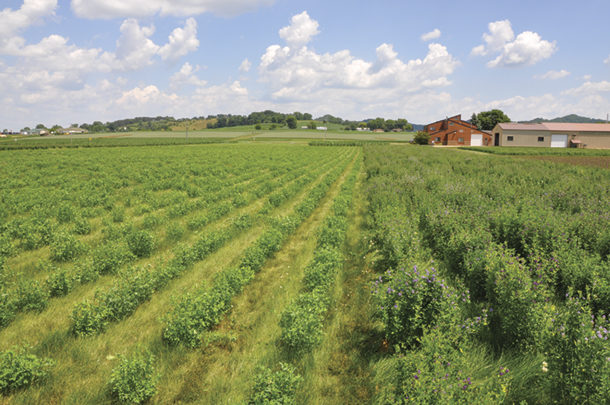Alfalfa breeders in 2019 registered over 70 new experimental alfalfa varieties for potential commercialization to provide producers varietal options to address the wide range of U.S. alfalfa growing conditions. Most alfalfa breeding still relies on traditional breeding methods where breeders select superior plants under field conditions or in specialized greenhouse selection tests. However, with alfalfa DNA-based gene discovery research in its third decade, alfalfa breeders are now getting closer to using this technology during variety development.
The two most prominent examples of DNA-based gene discovery technology being used in alfalfa breeding are the development of glyphosate-resistant alfalfa and lignin-modified alfalfa. Beyond these currently available alfalfa technologies, other gene discovery projects are underway that may lead to new improved alfalfa varieties. Mapping disease-resistant genes in alfalfa is one such class of projects.
Currently, researchers have completed gene mapping projects to determine genetic-resistant genes against anthracnose, aphanomyces root rot, bacterial stem blight, common leaf spot, leaf rust, phytophthora, root-knot nematode, and verticillium wilt. Public institutions have conducted this research with the intent that alfalfa breeders will incorporate knowledge of disease-resistant gene locations into alfalfa cultivar development and, indeed, for anthracnose resistance, there is evidence that Forage Genetics International is utilizing knowledge of disease-resistant genes to incorporate anthracnose resistance into some of their varieties.
Disease-resistant plant traits are most amenable to gene discovery and incorporation into alfalfa variety development because one or two major genes confer many alfalfa disease resistances. Determining genes for agronomically important traits is usually more difficult, as these plant traits are controlled by multiple genes and are much more susceptible to interactions with the plant’s growing environment.
Alfalfa plant traits for which chromosomal regions have been identified associated with the agronomic traits include: aluminum tolerance, drought tolerance, fall growth and/or dormancy, flowering, forage quality, forage yield, leafhopper resistance, leaf traits, lodging resistance, plant height, plant persistence, salt tolerance, self-fertility, spring vigor, stand regrowth speed, water use efficiency and winter survival and/or injury. Almost all these gene discovery projects have been conducted at public institutions with the intent that alfalfa breeders will be able to exploit this genic information to more rapidly and efficiently improve various associated traits.
As of yet, other than the lignin-modified alfalfa trait, none of the alfalfa plant genes discovered have been incorporated into alfalfa breeding programs. The main barriers to more fully utilizing genes discovered in alfalfa breeding include the genic state or “genotyping” evaluation cost for large numbers of plants in order to determine the best plants based on superior gene combinations at multiple genome locations.
For more complex plant traits such as forage yield, many genes are expected to influence this trait; therefore, many genome locations need to be evaluated to effectively predict forage yield from DNA-based information alone. Furthermore, even if sufficient genome locations can be evaluated, the overall cost to evaluate these genomic locations needs to be cost competitive with traditional field-based evaluation techniques. Current research is exploring how to achieve these objectives in alfalfa using emerging genotyping technologies.
Compounding this situation is the fact that even if a cost-effective genotyping technology is discovered, it is still unclear how to effectively implement such technology in an alfalfa breeding program. One challenge in alfalfa is that cultivated alfalfa is “autotetraploid,” meaning there are four copies of each chromosome (in humans there are two copies of chromosomes). Autotetraploidy, and the fact that alfalfa is open pollinated, makes it more difficult to predict plant performance based on DNA genotyping.
To tackle this challenge, the USDA Agricultural Research Service, the in-house research arm of the USDA, has initiated the alfalfa Breeding Insights Platform project, which aims to develop a cost-effective genotyping platform. The project brings together all the USDA-ARS alfalfa researchers from across the U.S. to work together to develop a cost-effective genotyping platform and to research how to effectively implement such a tool. The USDA-ARS research will build on research from the past decade conducted at the University of California –Davis and at the Council for Agricultural Research and Economics Research Centre for Fodder Crops and Dairy Productions in Lodi, Italy. This previous work has done initial studies utilizing alfalfa genotyping information to aid breeding projects using so-called “genomic selection.”
Results of this prior work has highlighted the complexity of the problem and has pointed the way for future research directions. Longer term it is the intent that the USDA-ARS breeding insight platform will be available to other public and private alfalfa breeders for implementation in alfalfa variety development. The USDA alfalfa breeding insights platform project is being funded through congressionally appropriated money. Both university and USDA researchers are also receiving grant funding for specific competitive research proposals submitted to congressionally funded USDA National Institute of Food and Agriculture’s (USDA-NIFA) alfalfa seed and alfalfa forage system program and the National Alfalfa Farmer Research Initiative (USAFRI), funded by the Alfalfa Checkoff Program.
Due to alfalfa’s perennial nature, it is anticipated that discovering cost-effective methodologies to incorporate mapped alfalfa genes into alfalfa breeding programs may take three to five more years. Many public and private alfalfa breeding programs are smaller and need to devote resources to their traditional breeding programs and, therefore, do not have the capacity to conduct DNA genotyping in-house. Many alfalfa breeders envision outsourcing DNA genotyping in the future to specialized businesses and then utilizing DNA genotyping information to make selection decisions in their breeding programs. Research conducted by the USDA-ARS and public universities are developing cost-effective genotyping technologies that will make this vision possible. ![]()
PHOTO: Alfalfa breeding nursery in West Salem, Wisconsin. Photo provided by Heathcliffe Riday.

-
Heathcliffe Riday
- Forage Legume Breeder
- U.S. Dairy Forage Research Center
- Email Heathcliffe Riday












